There were 8 indigenous men in the Battalion.
- CARLYON William WX15785
- FLARTY Neave WX17374
- HANSEN Robert WX15736
- HILL John WX8756
- MORRISON Arthur Edward WX15746
- NINYETTE Samuel WX16417
- RALPH Arthur WX20107
- RONAN Edward John WX1626
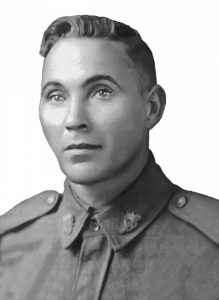
Right: Bill Carlyon
WX215785
Was working at Galena near Ajana, near Northampton when he enlisted. There were a number of enlistments from this area. Those who survived the battle for Singapore all went with ‘A’ Force Burma, Green force No. 3 Btn to Burma to work on the northern end of the Burma Thai Railway. Please read further about this work force.
Also read about the men from Northampton
Bill Carlyon used his bush knowledge, and risked his life to ‘go under the wire’ on the Burma-Thai Railway – seeking out plants which may be of medicinal and/or vitamin value for his mates who were starving and ill.
Bill with his dark complexion was often overlooked by Japanese guards and was able to move around more freely. The guards often found it challenging to distinguish ‘different’ nationalities amongst the local population. The POWs were also very skinny and undernourished.
We know the Japanese did not choose any POW with dark complexions, or freckles to send to Japan. They only sought out what they considered ‘men of European complexions’ to show off to their population in Japan.
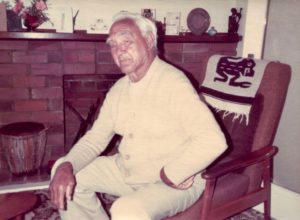
Please read further about Bill Carlyon.
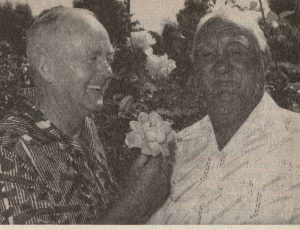
Soldier Reunited with Saviour – as per August 1985 “Barbed Wire and Bamboo”
The generosity of Onslow residents has reunited veteran Tom Hampton with a man who helped save his life in a Japanese prisoner of war camp.
When Mr Hampton needed an emergency stomach operation, Bill Carylon was among the prisoners who carried him 2km through thick Thai jungle to an Australian surgeon.
The two friends fought with the WA 2/4th Machine Gun Battalion. The last time they met was on a ship home after the war.
Now the Onslow community has got together to raise more than $1100 to send Mr Carylon (80) to Perth for his first ANZAC Day march and to see Mr Hampton again.
Mr Hampton (68) said – “I will never be able to repay Bill, but it is good to be able to thank him properly. I had a burst duodenal ulcer in the POW camp, and I thought that I would be lucky to survive. But some of the boys had heard about an Australian surgeon at a nearby camp. They made a stretcher and persuaded the Japanese to let them take me.”
Mr Carylon said, “They have been marvellous. It was a total surprise when they told me about the trip. It means so much to me to see the men of the battalion again and Tom.”
Onslow storekeeper, Mr Martin Petering said, “We are all so proud of Bill. He is a wonderful old man. We knew how much he wanted to take part in the Perth ANZAC Day parade, so we started raising the money”.

Robert Hansen, Bill Carlyon, Jimmy Till J & Les Kemp covered with red dirt in NT prior to sailing to Singapore Feb 1942. ( Photographer marked Lt Till with a cross for good luck – sadly Till died during battle for Singapore)
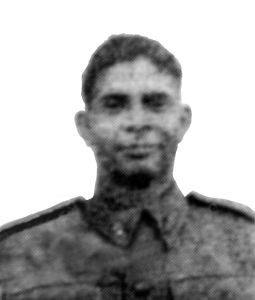
Robert HANSEN WX15736
Please read further about Bob Hansen.
Enlisted from Bridgetown.
Hansen was one of about 90 men from 2/4th who left transport ship ‘Aquitania’ anchored off Fremantle 15 Feb 1942 for one night on her journey to Singapore. These men sailed to Java instead where they were taken POWs of Japan just a few weeks after Singapore fell. Read further about this incident
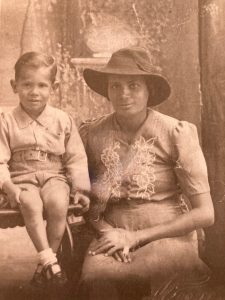
Above: this wonderful photo of Robert Hansen and his mother
WX16417 Samuel NINYETTE
We believe Ninyette was born in Beverley and was resident at Wagin when he enlisted. Samuel Ninyette had 6 children 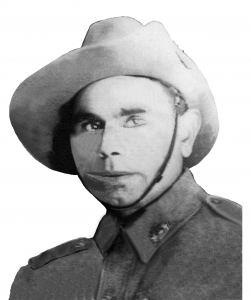 with his wife Emmeline Francis Jones whom he married at Wagin 17th July 1941.
with his wife Emmeline Francis Jones whom he married at Wagin 17th July 1941.
He died 17th February 1981at RPH and was buried at Serpentine.
Ninyette was one of more than 90 men from 2/4th who left ‘Aquitania’ when she anchored off Fremantle for one night on 15 Feb1942 and sailed for Singapore the following day.
Please read about these men who then sailed to Java.
Please read further about Sam Ninyette who died 17th February 1981 at RPH and was buried at Serpentine.
It is estimated about 3,000 Indigenous Australians served their country during WW2. Their experiences were mixed. On returning to civilian life most found they did not have access to War Service benefits such as those offered and accepted by non indigenous Australians in particular, War Service Loans for housing and War Service Farms. The opportunities and dreams that possibly urged them to enlist were not available.
Before 1967 indigenous men were denied a drink at the pub with their service mates! Indigenous were unable to enter Perth city radius – if they worked in the area they had a special pass.
It was acceptable to serve together, however not acceptable to march together on Anzac Day! Or share a drink at a bar with mates.
There are several stories of incidents with publicans/bar attendants demanding 2/4th indigenous who had gathered with mates for a drink being told they would not be served and to leave the premises. There was outrage and uproar until the publican’s decision was overturned.
These men had not survived 3 1/2 years together incarcerated as POW’s working as slave labourers, working in appalling and dangerous locations, starved, beaten, humiliated, living each day facing illness and injuries with no medication, watching their mates dying like flies to tolerate such appalling bigotry. They each knew the value of life and knew it was precious!
How often had they been there for each other during sickness and times of utter hopelessness?
The majority of former POWs remained a tight-knit group attending services and having a drink after. Of course they each wanted to get on and live their lives, but for many that was a dream only.
WX8756 John HILL
The only indigenous soldier 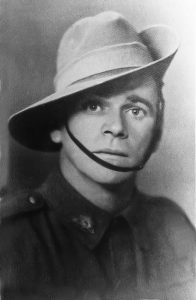 who did not return was Lance Corporal John Hill of ‘B’ Coy who died 11th March 1943.
who did not return was Lance Corporal John Hill of ‘B’ Coy who died 11th March 1943.
On 14th February 1942 John HIll was wounded in action at Pasir Panjang. With gunshot wounds to his left arm and head John Hill managed to drive his Bren gun carrier with his wounded and dead crew members to an aid post. On 16th February Lance Corporal Hill was admitted to 2/13th Australian General Hospital.
Hill was soon moved to Selarang Barracks where he faced a slow recovery. Hospitals had been set up here to deal with the large numbers of battle casualties.
He was later sent to Adam Park where he was sent out on work parties.
In late February 1943, John Hill was admitted to hospital with dysentery. On 11th March 1943 John Hill died at the Australian General Hospital at Roberts Barracks, Changi, from mycotoxicosis, diphtheria and acute but resolving bacillary dysentery. On Japanese orders his body was cremated and buried on 11 March.
The funeral service for Lance Corporal John Hill, aged 31 years was conducted by Chaplain G. Polain of 2/26th Battalion.
A member of the Wardandi Nation, John Hill was born in Fremantle, 1 January 1912, to Arthur and Margaret Hill. John was the eldest of nine children. The Hill family lived in a weatherboard cottage called “Snake Gully” in Busselton. John and his 3 brothers during free family time would go fishing with their father.
As young men, John and Roy saved to purchase a Chevrolet truck which they successfully sought contracting work and wheat carting in the wheat-belt area.
When war broke out John and two of his brothers enlisted. John on 23rd October 1940 into the Second Australian Imperial Force, Roy enlisted with Royal Australian Air Force and Harold with the Royal Australian Navy where he joined the crew of HMAS Perth.
When HMAS Perth sunk Harold too became a POW of the Japanese. In October 1942 Harold passed through Singapore on his journey to Burma-Thai Railway. Sadly the two brothers did not meet.
Harold and Roy survived the war to return home.
Roy Hill became a pilot and officer in Bomber Command. He served in Britain with the RAF flying Lancasters.
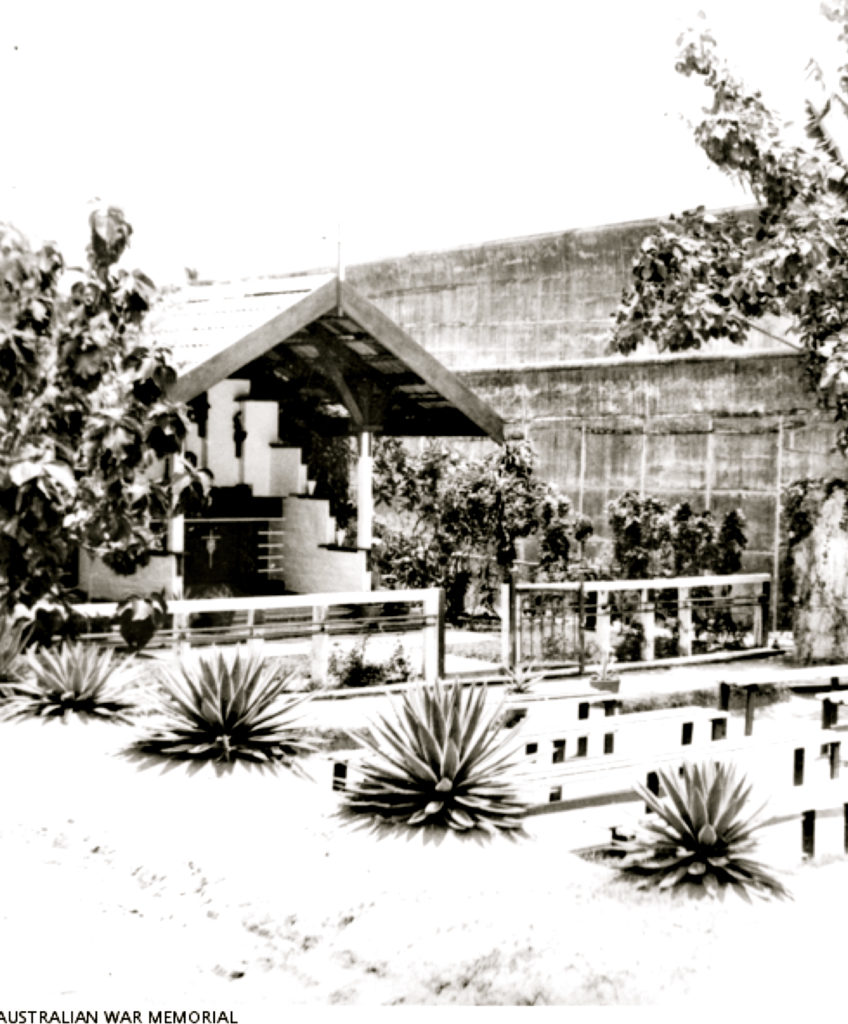
The original cross was collected and taken back to Western Australia by John Hill’s mates. It was later donated to AWM, Canberra.
The Last Post Ceremony is presented in the Commemorative area of the Australian War Memorial each day. The ceremony commemorates more than 102,000 Australians who have given their lives in war and other operations and whose names are recorded on the Roll of Honour. At each ceremony the story behind one of the names on the Roll of Honour is told. Hosted by Richard Cruise, the story for 22 September 2016 was (WX8756) Lance Corporal John Hill, 2/4th Machine Gun Battalion, 2nd AIF, Second World War. John Hill’s photograph was displayed beside the Pool of Reflection. Watch a recording of the ceremony courtesy of the Australian War Memorial.
Below: is the wooden cross made for John Hill and brought back to Australia by his 2/4th mates.

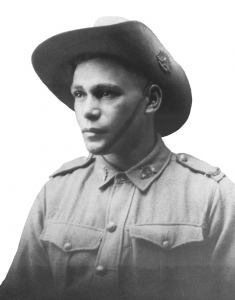
WX15746 Arthur Morrison
Arthur’s nickname was ‘Snow White’ – nothing to do with his skin colour – please read further.
Arthur was sent to Java and then to Burma-Railway with ‘A’ Force Burma Java Party No. 4 Williams Force. This work Force endured a pretty torrid time because most were members of 2/2nd Pioneers, an Engineering Force who were shipped back from the Middle East intended to reinforce Singapore. They landed at Java and were captured there about 8 March 1942. The Japanese were excited to have so many qualified and experienced engineering POWs – and was the reason Williams Force were moved frequently up and down the Burma end of the Railway. They had little rest and were never in one place very long. Working all day, and walking to the next place at night and usually began working again that same morning.
‘Snow White’ attended most reunions. Well liked and respected by all, Arthur’s arrival was always welcomed. The men loved to get together – they never talked about the terrible memories – just laughed as they re-told the funny ones!
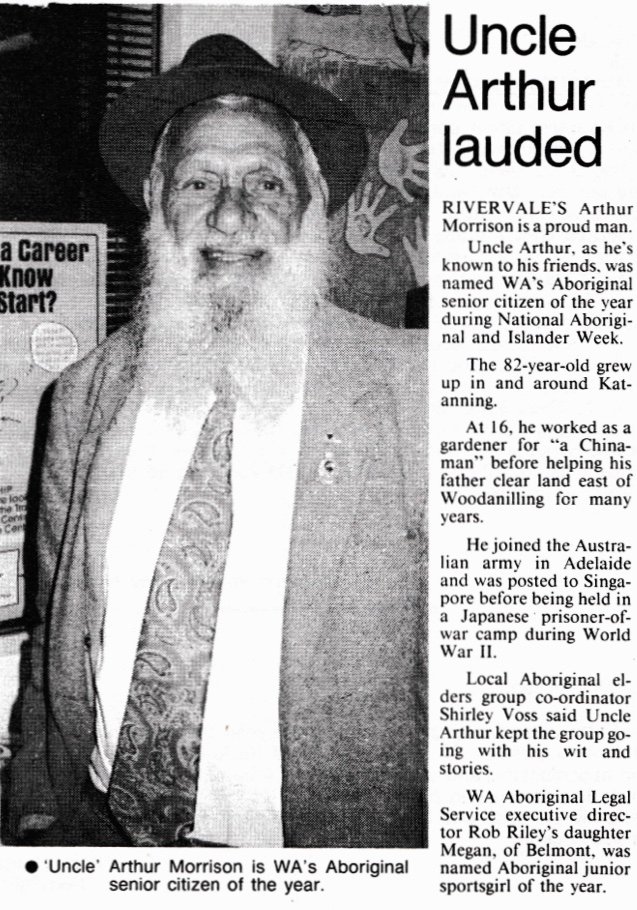

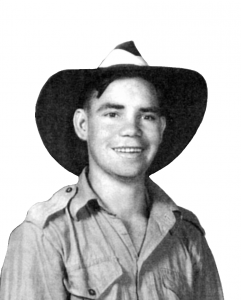
WX17374 Neave FLARTY
Sadly very little is known of Neave. He died in Queensland 30 January 1980. He was 57years old and buried Collinsville Cemetery, Collinsville, Whitsunday Region, Queensland, Australia. You can read further information about Neave.
Flarty enlisted 22 Oct 1941 and was sent with reinforcements to board ‘Aquitania’ sailing to Singapore on 16 Jan 1942. He was lucky to survive the Japanese ambush at South West Bukit Timah, was injured and carried to safety by a mate.
Neave worked on the Burma-Thai Railway with ‘D’ Force T Battalion. He was recovered from Ubon POW Camp in Thailand when the war ended.
Should any family and/or persons with knowledge are able to provide information can you please contact us Email: 2nd4thmgb@gmail.com
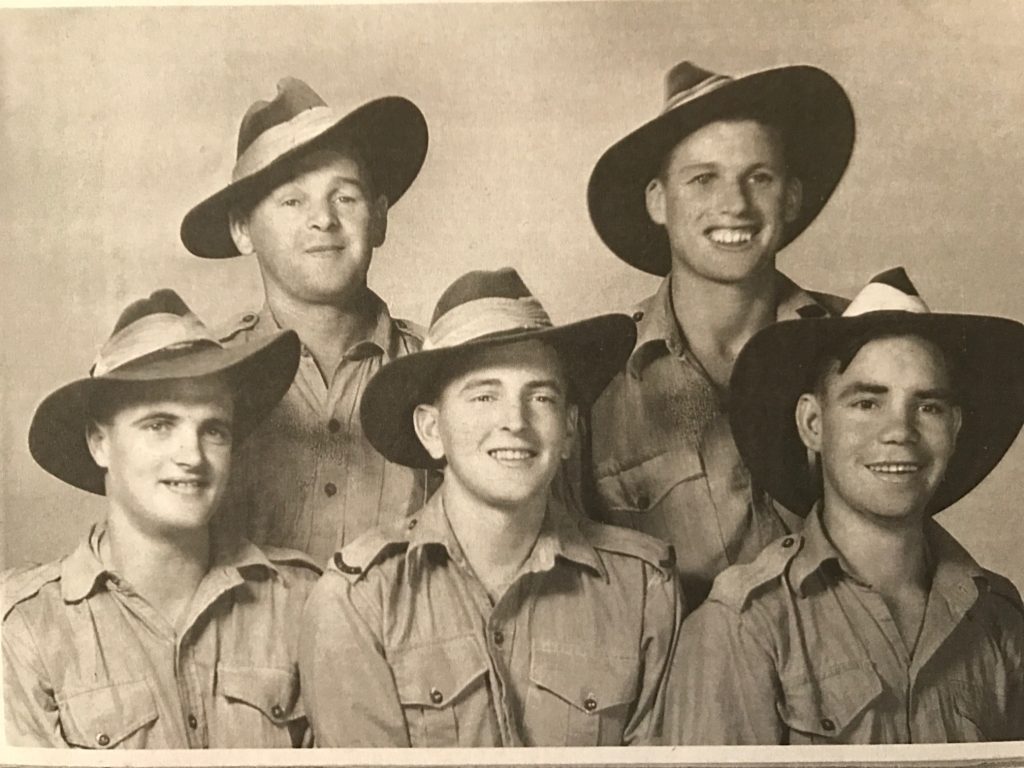
Front L-R M.Wilkins, T.Gough & N.Flarty.
During the battle at Singapore, Wilkes carried his mate Flarty (who had suffered gunshot wound to his knee) back to safety.)
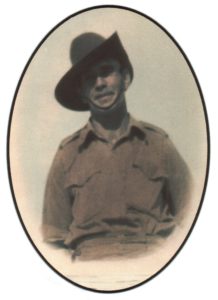
WX20107 Arthur RALPH remained at Singapore throughout the war, He dislocated ligaments in right knee on 12/2/1942 and was evacuated to Alexandra Hospital until end of hostilities. Discharged to unit on 22/2/1942.
12 Aug 42 AGH beri beri.
14 Mar 1943 admitted AGH encephalitis discharged 20 Mar 1943, admitted with dysentery 25 Mar 1943 discharged 31 Mar 1943. Arthur missed working parties to the Railway Line due to illness. He was sent with a work party to Blakang Mati Island 5 Nov 43, where living conditions were reasonable however Japanese brutality and punishments were frequent and work conditions tough and often violent. Please read further about Arthur Ralph
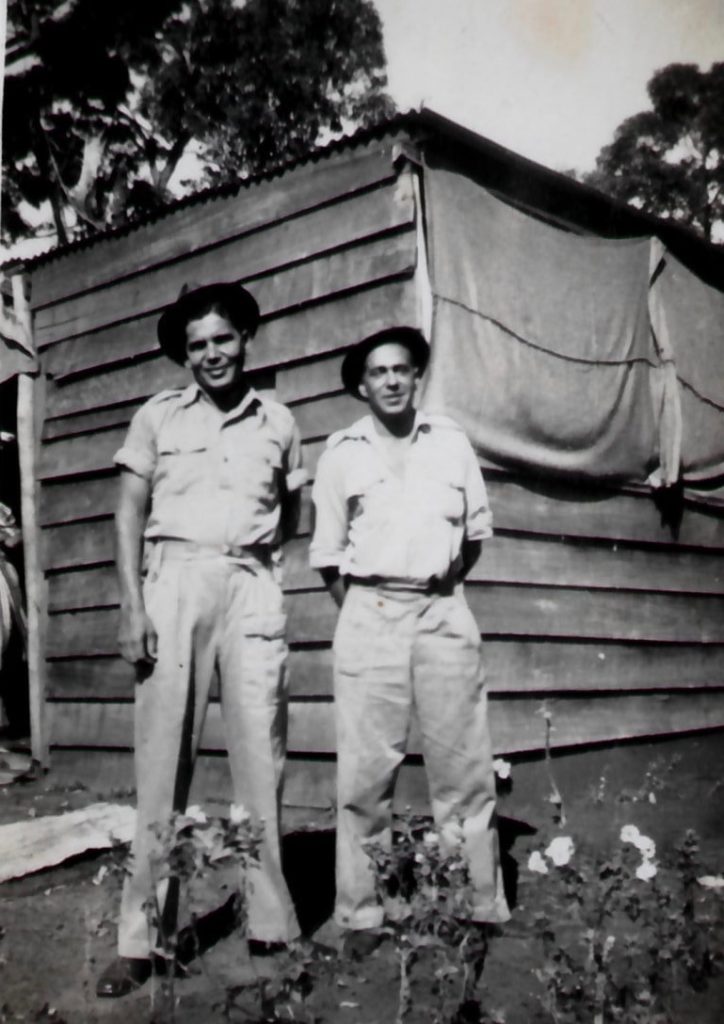

WX26269 Edward John ‘Ted’ RONAN
Was born at Mingenew 1917. Prior to enlisting 27 Aug 1941 Ted worked as a miner. He joined the large number of (mostly untrained newly enlisted) reinforcements to 2/4th, ‘E’ Company SRB – they joined the Battalion at Fremantle when the boarded ‘Aquitania’ and sailed for Singapore on 16 January 1942.
He was one of the fortunate to survive the Japanese ambush at south west Bukit Timah when ‘E’ Company lost almost half of the battalion to those wounded and those who were KIA.
As a POW in Singapore Ted was unfortunate to leave with ‘D’ Force Thailand V Battalion to work on the Burma-Thai Railway.
This Force endured nearly 50% death rate from starvation, terrible tropical illness and Japanese brutality. Please read
Ted was recovered from Ubon Camp at the end of the war.
Right: Ted Ronan. He died April 1991 Busselton aged 73 years where he resided with his wife Phyllis. You can read further about Ted and his family
PLEASE NOTE:
‘FOREVER WARRIORS’ by Jan James of Northam includes the name of WX7213 Gilbert Valentine HADDEN of Leonora.
Ms James died about 2021. Historian Cheryl Mellor visited her at Northern however Ms James had no plans to reprint her book which would have provided her the means to rectify this mistake.
C. Mellor also spoke with a granddaughter of Hadden who had just by chance recently received her DNA results – she did not have any indigenous ancestry.
We believe this incorrect information came about because the 2/4th nickname for Hadden was ‘Boong’ acquired because Hadden was deeply tanned from years of prospecting in the Goldfields. His appearance did not change during his time working on the Burma-Thai Railway where the POWs were dressed only in ‘Jap happies’.
It was Dick Ridgwell and Ron Badock who confirmed these details for us.
We apologise to anybody offended by the use of the word ‘Boong’ – it was the 1940’s, it was the Army and it was war. It appears nobody was offended at that time.
If you would like to read further about Gilbert Hadden, please go to
18 Nov 2023
I have been communication with Heather Young, daughter of Jan James. Heather has reprinted ‘Forever Warriors’ written by Jan James. Unfortunately, Heather was not aware of the incorrect inclusion of Gilbert Hadden from 2/4th. She has made notes if she reprints.
Heather Young has copies of ‘Forever Warriors’ – Cost $90.00 plus postage, $12.00 in Australia. Heather can be contacted by phone:
0448589559.
Below is a brief overview of the Men’s Companies, Work Parties etc so you can see where they were sent, and if any were together.
-
CARLYON William WX15785 – HQ Coy No. 3 Platoon – joined 2/4th 5 Oct 1941 Woodside SA.
-
FLARTY Neave WX17374 – ‘E’ Company SRB. Reinforcement Fremantle. Worked Burma-Thai Railway with ‘D’ Force Thailand, T Battalion.
-
HANSEN Robert WX15736 – ‘D’ Coy 15 Platoon (Reif) – Captured Java – ‘Blackforce’ – Williams Force to Thai-Burma Railway – (joined 2/4th 5 Oct 1941 Woodside SA.)
-
HILL John WX8756 – ‘B’ Coy 8 Platoon – Original Member 2/4th
-
MORRISON Arthur Edward WX15746 – ‘D’ Coy 13 Platoon (Reif) ‘Blackforce’ attached 2/2nd Pioneer Battalion, Captured Java, Williams Force to Thai-Burma Railway – (joined 2/4th Woodside SA 5 Oct 1941)
-
NINYETTE Samuel WX16417 – ‘D’ Coy, 16 Platoon (Reif) – Captured Java – ‘Blackforce’ – Williams Force to Thai-Burma Line. (joined 2/4th 5 Oct 1941 at Woodside SA.)
-
RALPH Arthur WX20107 – ‘E’ Coy SRB. Reinforcement Fremantle. Remained in Singapore throughout war.
-
RONAN Edward John WX1626 – ‘E’ Coy SRB. Reinforcement Fremantle
Lance Corporal John Hill died of illness March 1943 at Singapore aged 31 years. Hill was very popular amongst the 2/4th. The men constructed a wooden cross for John, which at the end war was brought back with those in Singapore. It was donated to AWM.
Hansen, Ninyette, Morrison were taken POWs March 1942 at Java, having missed transport ship ‘Aquitania’ which sailed from Fremantle 16 Jan 1942. Morrison, Hansen and Ninyette worked with Williams Force, most of whom were from engineering 2/2nd Pioneer Btn from Middle East. Williams Force were constantly moved up and down the railway, repairing the track.
WX20107 Arthur RALPH survived ambush at SW Bukit Timah with ‘E’ Coy however dislocated ligaments in his right knee 12 Feb and was evacuated to Alexandria Hospital. Remained Singapore due to ill-health and missed working on Railway. He was included in work party to Blakang Mati Island Nov 43. POWs faced terrible Japanese brutality and work conditions here. Recovered Singapore.
Neave Flarty was a reinforcement with ‘E’ Coy – wounded during Japanese ambush at SW Bukit Timah, however was carried by mate to safety. Flarty worked on Burma-Thai Railway with D Force T Battalion. Recovered from Ubon at end of war as was Ronan.
WX26269 Edward John ‘Ted’ RONAN like Flarty was a reinforcement. He fortunately survived the SW Bukit Timah ambush where nearly half of ‘E’ Coy were KIA or WIA. He left Singapore with ‘D’ Force Thailand V Battalion – a work force which endured too many deaths and shocking working and living conditions on Burma-Thai Railway. Recovered from Ubon at end of war with Flarty.
